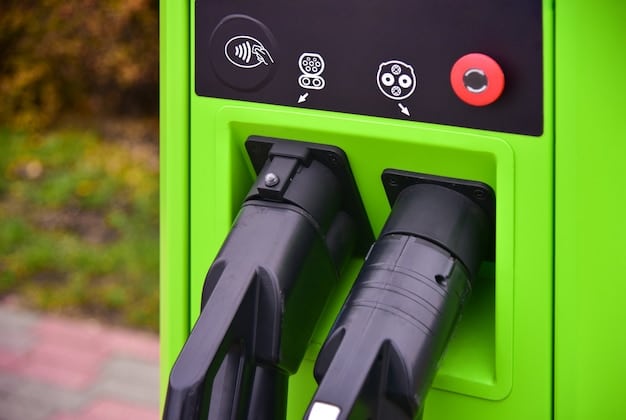New Car Incentives 2025: Rebates and Tax Credits Guide

Navigating **new car incentives in 2025** requires understanding available rebates and tax credits at the federal, state, and local levels, ensuring you maximize savings on your next vehicle purchase through careful research and eligibility verification.
Planning to buy a new car in 2025? Understanding **new car incentives in 2025** can significantly reduce your purchase price. This guide helps you find and claim available rebates and tax credits to maximize your savings.
Understanding Federal Tax Credits for New Cars
Federal tax credits are significant financial incentives offered by the U.S. government to encourage consumers to purchase new, energy-efficient vehicles. These credits help offset the initial cost, making them more accessible and appealing to a broader range of buyers.
The Inflation Reduction Act and Tax Credits
The Inflation Reduction Act (IRA) has reshaped the landscape of federal electric vehicle (EV) tax credits. Understanding how the IRA impacts these credits is crucial for anyone considering buying a new EV.
The IRA introduced several key changes to the EV tax credit program, including:
- Income Limitations: Buyers with higher incomes may not be eligible for the full credit. This targets the incentives towards those who need them most.
- Vehicle Price Caps: Certain vehicles exceeding a specified price threshold are not eligible, promoting affordability.
- Battery Sourcing Requirements: Vehicles must meet specific battery sourcing criteria to qualify, encouraging domestic manufacturing and supply chains.

How to Determine Eligibility for Federal Tax Credits
Determining your eligibility for these credits requires careful evaluation of several factors. Here’s what you need to consider:
- Review the IRS Guidelines: The IRS provides detailed guidelines on eligibility criteria, including income limits and vehicle requirements.
- Check Vehicle Specifications: Ensure the vehicle you’re considering meets the necessary requirements, such as battery sourcing and price caps.
- Consult a Tax Professional: Seek advice from a tax professional to navigate the complexities and ensure accurate filing.
Federal tax credits can substantially lower the cost of a new, energy-efficient vehicle. By understanding the IRA’s changes and carefully evaluating eligibility, buyers can take full advantage of these incentives.
Exploring State and Local Rebates
In addition to federal incentives, state and local governments also offer rebates and tax credits to encourage the adoption of new, energy-efficient vehicles. These incentives can vary significantly by location, so it’s important to understand what’s available in your area.
Overview of Available State Rebates
Many states offer rebates for purchasing or leasing new electric vehicles (EVs) and plug-in hybrid electric vehicles (PHEVs). These rebates provide additional savings beyond the federal tax credit.
Some examples of state rebates include:
- California: The Clean Vehicle Rebate Project (CVRP) offers rebates for eligible EVs and PHEVs, with amounts varying based on income and vehicle type.
- Colorado: Provides a state income tax credit for the purchase or lease of new EVs, with the credit amount depending on the vehicle’s battery capacity.
- Massachusetts: The MOR-EV program offers rebates for eligible EVs and PHEVs, aiming to reduce greenhouse gas emissions.
Finding Local Incentives and Utility Programs
Local incentives and utility programs can further enhance the savings available to new car buyers. These programs often focus on promoting sustainable transportation and energy efficiency.

To find local incentives and utility programs:
- Check with Your Local Government: Visit your city or county’s website to explore available rebates and tax credits.
- Contact Your Utility Company: Many utility companies offer rebates for purchasing EVs or installing home charging stations.
- Explore Online Databases: Websites like the Database of State Incentives for Renewables & Efficiency (DSIRE) compile state and local incentives.
Exploring state and local rebates can uncover significant additional savings, making new, energy-efficient vehicles even more affordable. By understanding the incentives available in your area, you can make a more informed decision when purchasing your next car.
Types of New Car Incentives Available
When shopping for a new car, several types of incentives can help reduce the overall cost. Understanding these different incentives allows you to make informed decisions and maximize your savings.
Manufacturer Rebates and Discounts
Manufacturers often offer rebates and discounts to promote sales and clear inventory. These incentives can be a significant source of savings for new car buyers.
Cash Rebates
Cash rebates are direct discounts offered by the manufacturer, typically deducted from the purchase price. These rebates can be advertised or unadvertised, so it’s important to inquire with the dealer.
Low-Interest Financing
Manufacturers sometimes offer low-interest or zero-percent financing to attract buyers. This can save you money on interest payments over the life of the loan, but it’s crucial to compare the terms with other financing options.
Several types of incentives are commonly available:
- Model-Specific Rebates: Targeted at specific models to boost sales.
- Regional Offers: Available only in certain geographic areas.
- Bonus Cash: Additional incentives for qualified buyers, such as military members or recent graduates.
Lease Deals
Leasing can be an attractive option for some buyers, with manufacturers often offering special lease deals. These deals may include lower monthly payments or reduced upfront costs.
Understanding how different incentives work is crucial for saving money on a new car purchase. By exploring manufacturer rebates, low-interest financing, and lease deals, you can find the best options for your budget.
How to Negotiate for Additional Savings
Negotiating effectively can result in significant savings beyond the advertised incentives. Developing strong negotiation skills is key to getting the best possible deal on a new car.
Researching Market Prices and Dealer Incentives
Before heading to the dealership, conduct thorough research to understand market prices and dealer incentives. This knowledge empowers you to negotiate from a position of strength.
Using Online Resources
Online resources like Kelley Blue Book (KBB) and Edmunds provide valuable information on market values, invoice prices, and available incentives.
Contacting Multiple Dealerships
Contact multiple dealerships to compare prices and incentives. This creates competition and increases your chances of securing a favorable deal.
Key strategies include:
- Know the Invoice Price: The invoice price is what the dealer pays for the car, giving you a benchmark for negotiation.
- Understand the Market Value: Knowing the fair market value helps you determine a reasonable offer.
- Be Prepared to Walk Away: Dealerships are often more willing to negotiate if they know you are ready to walk away.
Negotiation Techniques
Effective negotiation techniques can help you maximize your savings. Here are some strategies to consider:
- Start Low: Begin with a lower offer than what you’re willing to pay and negotiate upwards.
- Focus on the Out-the-Door Price: Concentrate on the total price, including taxes and fees, to avoid hidden costs.
- Separate Financing from Price: Negotiate the car price before discussing financing to get the best possible deal on both.
Negotiating for additional savings requires preparation, research, and effective communication. By understanding market prices, dealer incentives, and negotiation techniques, you can increase your chances of getting a great deal on a new car.
Tax Implications of New Car Incentives
Understanding the tax implications of new car incentives is crucial for accurate financial planning. Tax credits and rebates can affect your tax liability, so it’s important to be aware of the rules and regulations.
How Tax Credits Affect Your Tax Liability
Tax credits directly reduce the amount of tax you owe, providing a dollar-for-dollar reduction in your tax liability. Understanding how these credits work is essential for maximizing their benefit.
Key points to consider:
- Eligibility Requirements: Ensure you meet all eligibility requirements to claim the credit.
- Filing Requirements: Follow the IRS guidelines for claiming the credit on your tax return.
- Record Keeping: Keep accurate records of the purchase and any relevant documentation.
Reporting Incentives on Your Tax Return
When filing your tax return, you’ll need to report the new car incentives you received. This typically involves completing specific tax forms and providing documentation to support your claim.
IRS Form 8936: Clean Vehicle Credits
To claim the federal EV tax credit, you will likely need to file IRS Form 8936, Clean Vehicle Credits. This form requires information about the vehicle and the credit amount.
Reporting new car incentives properly on your tax return is essential for compliance and maximizing your tax benefits. By understanding the tax implications and following the IRS guidelines, you can ensure accurate filing and optimize your financial planning.
Future Trends in Car Buying Incentives
As the automotive industry evolves, so do the incentives offered to new car buyers. Staying informed about future trends can help you make strategic decisions and take advantage of emerging opportunities.
Expected Changes in Federal and State Programs
Anticipating changes in federal and state incentive programs is crucial for planning your future car purchases. These programs are subject to legislative changes and evolving priorities.
Technological Advancements and Incentive Adjustments
Technological advancements in the automotive industry can influence incentive adjustments. As new technologies emerge, incentives may be tailored to promote their adoption.
Anticipated trends include:
- Increased Focus on Electric Vehicles: Incentives are likely to continue favoring EVs as governments push for cleaner transportation.
- Expansion of Charging Infrastructure: Programs supporting the installation of EV charging stations may become more prevalent.
- Performance-Based Incentives: Incentives may be tied to vehicle performance metrics, such as range and efficiency.
The Role of Automakers in Shaping Future Incentives
Automakers play a significant role in shaping future incentives by collaborating with governments and advocating for policies that support their products. Their involvement can influence the types of incentives offered and their accessibility.
Staying informed about future trends in car buying incentives requires continuous monitoring of industry developments and regulatory changes. By understanding these trends, you can make informed decisions and position yourself to benefit from emerging opportunities.
| Key Point | Brief Description |
|---|---|
| 💰 Federal Tax Credits | Understand eligibility for EV tax credits under the Inflation Reduction Act. |
| 📍 State & Local Rebates | Explore state and local incentives to maximize savings. |
| 딜 Negotiate Savings | Research market prices and use effective negotiation techniques. |
| 📈 Future Trends | Stay informed on changes in federal, state, and technology-driven incentives. |
Frequently Asked Questions (FAQ)
▼
The IRA significantly modifies federal EV tax credits by introducing income limitations, vehicle price caps, and battery sourcing requirements to ensure broader access and promote domestic manufacturing.
▼
Check the IRS guidelines for income limits, verify the vehicle meets battery sourcing and price requirements, and consult a tax professional for personalized advice on your eligibility.
▼
California’s Clean Vehicle Rebate Project (CVRP), Colorado’s state income tax credit, and Massachusetts’ MOR-EV program offer rebates for eligible electric and plug-in hybrid vehicles.
▼
Expect cash rebates, low-interest financing, and attractive lease deals. These incentives often vary by model, region, or buyer qualifications, such as military service or recent graduation.
▼
Research market prices, contact multiple dealers to encourage competition, and focus on the out-the-door price. Be prepared to walk away if your terms are not met by the dealer.
Conclusion
Navigating the landscape of new car incentives in 2025 can significantly reduce your purchasing costs. By understanding federal tax credits, exploring state and local rebates, and employing effective negotiation strategies, you can make an informed decision and drive away with a great deal.





